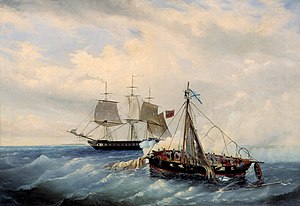Battle of the Nargö
| Battle of the Nargö | |||||||
|---|---|---|---|---|---|---|---|
| Part of Anglo-Russian War (1807–1812) as part of Napoleonic Wars | |||||||
 The unequal battle of the Russian boat Opyt with the British frigate Salsette off Nargen Island on June 11, 1808.". By Leonid Blinov. | |||||||
| |||||||
| Belligerents | |||||||
| Commanders and leaders | |||||||
|
|
| ||||||
| Units involved | |||||||
| Salsette | Opyt | ||||||
| Strength | |||||||
| 400 men | 53 men | ||||||
| Casualties and losses | |||||||
| Unknown |
2 killed 11 wounded | ||||||
Battle of the Nargö (Битва у Наргена) was one of the few direct clashes during the Russian-British War.
Participants of the battle
[edit]Russians
[edit]The Russian sailing and rowing boat was launched in 1806. It was made of wood and held about 14- and 12-pounder guns. It had a crew of 53.[1]
British
[edit]The British frigate, which was much better armed and had a crew of 400 people, fought against the Russian cruiser.[2]
Background
[edit]Speedboat Opyt had taken part in the siege of Sveaborg, in 1808, and it and the corvette Sharlotta patrolled the vicinity of Gangut, when they met a large number of Swedish ships, they avoided the battle, but Sharlotta was lost and Commander Nevelsky needed to find her.[3]
Battle
[edit]On June 11, near the Estonian coast, the Experience team saw a ship without distinguishing signs. Nevelsky thought it was Sharlotta and headed for her, but it turned out to be an English frigate. The Russians realized the mistake and began to retreat under hail. Nevelsky wanted to break the ship aground, just not to give up.[4] However, the ship had already been heavily damaged and it began to defend itself.
The battle lasted four hours and only after part of the team was seriously wounded, Nevelsky lost consciousness from blood loss, then the ship surrendered, but did not lower the flag.[5] British commander admired the bravery of the Russians and refused to take a sword from the commander of the Russian boat, instead, as a sign of respect, he let them go back to Russia.[2] The Russians lost 2 killed and 11 wounded in this battle.[6]
Reference
[edit]- ^ Chernyshev 2002, pp. 114–115.
- ^ a b Sokurov 2012.
- ^ Nive 1910, p. 214.
- ^ Nive 1910, p. 215.
- ^ Veselago 1871, p. 11.
- ^ 11 июня 1808 г. Бой катера “Опыт” с английским фрегатом
Bibliography
[edit]- Veselago, F. (1871). Краткие сведения о русских морских сражениях за два столетия с 1656 по 1856 [Brief information about Russian naval battles over two centuries from 1656 to 1856] (in Russian).
- Sokurov, Sergei (2012). Забытые войны России: Морские особенности одной «вялой» войны [Russia's Forgotten Wars: Marine features of one "sluggish" war]. Суждения (in Russian).
- Chernyshev, Alexander (2002). Русский парусный флот [Russian Sailing Fleet] (in Russian). Volume 2. Moscow: Voenizdat. ISBN 5-203-01789-1.
- Nive, Pyotr (1910). Русско-шведская война 1808—09 гг. [Russo-Swedish 1808-1809] (in Russian). St. Petersburg: Военная Типография.
